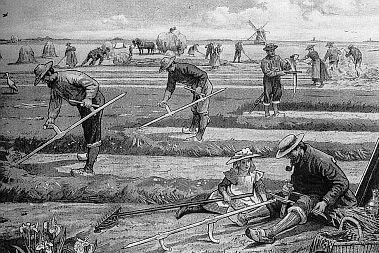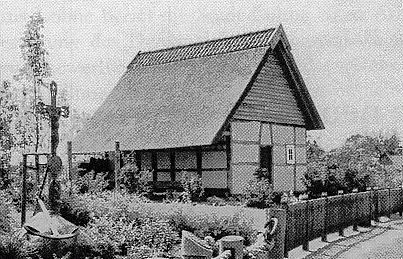Emigrants from the former
Amt Damme, Oldenburg (now Niedersachsen), Germany,
mainly to the United States,
1830-1849
Der Hollandgang - The Trek to Holland
by
Bernard Völkerding
Over a period of circa 300 years, between 1600 to 1900, each year in
the early Sumer months, a stream of migrant workers in the Northwestern
section of Germany made the trek to Holland, where they found employment
for several weeks and months. This trek had its beginnings in the early
part of the 17th Century, thus coinciding with the inception of the Heuerling
System. As the Heuerling System grew, the trek to Holland grew with
it, to the point that it was a mass people movement. Recent studies indicate
that the heartland of the trek, which certainly includes Holdorf .....probably
every second male adult, and with certainty the bulk of the Heuerleute,
annually came to the coastal area of the North Sea as migrant workers.
Confirmation of this trend comes from the statements by Johann Theodor
Moormann, according to which nearly all adults plus other able bodied
males of the Heuerleute migrated to Holland during the Summer.
We could cite a number here, from a report in the vear 1806 - a time
past the apex of the migrant worker movement - which indicates that for
the Damme Parish, to which Holdorf belonged until 1827 - between
350 and 380 persons made trek to Holland. This corresponds to 5% of the
total population (of the Parish) which amounted to 7 000 persons, and 30%
of the male adults.
 The nature of the activity in Holland covered two principal areas: Work
with grass and processing turf (Peat Moss). Much less important were the
number of seafarers and those involved in the construction trades.
For this reasaon we shall not delve further into the latter categories
in this report.
The nature of the activity in Holland covered two principal areas: Work
with grass and processing turf (Peat Moss). Much less important were the
number of seafarers and those involved in the construction trades.
For this reasaon we shall not delve further into the latter categories
in this report.
The bulk of the Holland trekkers found work in the grass and hay fields,
which can be attributed to the confluence of several favorable trends.
The farm economy back hone in the months of May and June experienced a
slack period; such chores as needed to be attended could be handled by
the wives and children. So the Heuermann's services were available elsewhere.
On the other hand, the Dutch economy in this period was at its most
Labor intensive time. Here far reaching progress had been made
in the dairy industry; large dairy herds dominated the vista. The
cows depended on hay for feed in the Winter months, which was brought in
large quantity for storage in the early Summer months. Speed was
essential and every helping hand most welcome.
A long range relationstiip between the Dutch farmer and his mowers
would soon develop. As a rule it was the same grass workers who would
annually report to any given farmer. And if one or the other would
drop out, he would arrange for a replacement, whether for a given season,
or permanently. Particularly, in the 18th Century a certain communication
system developed. When the grass harvest season was approaching the
farmer (who was called "Bass") would inform, by mail, his recent worker,
who in turn would notify ther others in his group, perhaps arrange for
suitable substitutes. The departure of these workers occurred in
groups. A major assembly point for them was the bridge
over the Ems River near Lingen. Per season as may as 25 000
Holland trekkers would come by here. From this assembly point the trekkers
would branch out to their various destinations. The trip to and from
seasonal employment would take a week in each direction, and would invariably
be done on foot. The trip in and of itself had its problems, if one
remembers that beside the required tools, changes of clothes and such,
the trekker would have to bring along basic foodstuff's from home. He made
every effort to keep his upkeep on the Holland trek to a minimum.
The grassmowing operation was performed in a rhythm. The pace was set
by one particulary enduring "foreman". Weaker mowers naturally were more
of a hindrance and if they persevered in their activity could have a damaging
effect on the overall effort. Sunday was a work-free day, but all other
days the work day would begin at 4:00 am and end at 8:00 pm. Short
breaks were few and far between. The night was spent in the farmer's
barn.
Numerous factors combined to make this a hazardous occupation.
The 16-hour workday, the stressfulness of this activity, the skimpy meals,
the inadequate shelter, frequently prompted damage to a worker's health.
Serious illnesses, often chronic, even death could be brought on by this
existence; most notably, it was premature ageing which could be expected
by the grassworker.
Yet the peat moss workers were exposed to far greater dangers.
He who did not have a strong constitution could quickly become a victim
of the harsh working conditions. The dismantling of the peat bogs
took place in the Niedermooren, which is just below sealevel. The
workers would stand in water to their knees, which would be ice cold in
the Spring months. In the summer heat their bodies would be exposed
to the broiling sun, without protection to the torso. If this exposure
would not be enough, their accomodations were such as to guarantee permanent
damage to their health. Their shacks were in the Moor, far from any
human habitation. They consisted of piled turf, with a roof made
of loose tiles, which offered practically no protection from rain or wind.
"Mattresses" would consist of a thin layer of brushwood atop the barren
peat ground. For cover they would have one "blanket", which
consisted of coffee sacks, sewn together. It is hard to think of
a better breeding ground for fevers, lung infections, gout, rheumatism
and other illnesses.
What made this activity an even harder burden was the length of the
"season" which lasted from early Spring into the Fall. Whoever of the Holland
trekkers opted for the peat moss,operation did this because of the higher
earnings expected due to the longer season here, than for the grass workers.
Early in the 19th Century the flourishing Dutch economy began a decline,
due to the overpowering British efforts. This was not without effect on
the Holland trek. If until then there was a labor shortage in Holland,
now there was excess of willing hands. Those of the Dutch workers
who had lost jobs were now competing for work with German migrant workers.
It should be noted that they (the Dutch workers) never quite succeeded
in displacing them altogether. This excess of available labor had
a depressing effect on wage rates. The difficulty of the tasks and
the high expenses in no way matched the wages the worker was paid.
It is therefore quite astounding that in the year 1860 there still were
close to 1000 Holland trekkers in the Vechta District. In fact, this
activity did, not end altogether until the end of the 19th Century.
Source: Gemeindechronik Holdorf 1188 - 1988,
Community History Holdorf (Kreis Vechta, Province Oldenburg)
Publisher: Gemeinde Holdorf * Grosse Str.
19 * 49449 Holdorf, ISBN 3-88441-032-6
Translated by Eric Oppenheimer July 1998, the translator
warned:
many of terms associated with political, social and
economic matters were specific to that perid and place, and it is hard
to express these in modern terms.
from: Elaine
Moser, 9231 Lodge Pole Ln, Saint Louis, MO 63126
Addition:
 The Büsgängerei (seasonal work on Dutch herring and whale
fishing boats) joined the classic form known as Hollandgängerei (seasonal
migration to work in the Netherlands) during the 18th century. The Büsgängerei
found great popularity among the Heuerleuten (landless peasants) in the
southern areas of today's county of Vechta.
The Büsgängerei (seasonal work on Dutch herring and whale
fishing boats) joined the classic form known as Hollandgängerei (seasonal
migration to work in the Netherlands) during the 18th century. The Büsgängerei
found great popularity among the Heuerleuten (landless peasants) in the
southern areas of today's county of Vechta.
In the middle of the 18th century hundreds of young people form the
areas of Damme, Neuenkirchen, Vörden and other parishes left to go
to various Dutch ports to then typically remain for half a year at sea.
The piecework system of the Hollandgänger in the country
corresponded to a form of proft-sharing in the maritime work of the
Büsgänger who were paid according to the yield of the catch in
thier respective season. This maritime seasonal work was ridden by crisis
during the restless years between the French revolution and Napoleon's
eventual defeat, however, during the course of the early 19th century it
experienced a late flowerering. A navigational school was founded in Mühlen/Steinfeld.
Here young people could become trained in the occupation of work at sea.
The differences between maritime seasonal work and professional seafaring
now became progressively blurred. As of the middle of the 19th century
all manifestations of migratory work lost more and more meaning, mostly
because of the possibility of mass emigration to America.
Picture: seaman school in Steinfeld-Mühlen (rebuild)
Source:"Schaufenster Geschichte Landkreis Vechta",
ISBN 3-9804776-6-5
Back to the contents list
 The nature of the activity in Holland covered two principal areas: Work
with grass and processing turf (Peat Moss). Much less important were the
number of seafarers and those involved in the construction trades.
For this reasaon we shall not delve further into the latter categories
in this report.
The nature of the activity in Holland covered two principal areas: Work
with grass and processing turf (Peat Moss). Much less important were the
number of seafarers and those involved in the construction trades.
For this reasaon we shall not delve further into the latter categories
in this report.
 The Büsgängerei (seasonal work on Dutch herring and whale
fishing boats) joined the classic form known as Hollandgängerei (seasonal
migration to work in the Netherlands) during the 18th century. The Büsgängerei
found great popularity among the Heuerleuten (landless peasants) in the
southern areas of today's county of Vechta.
The Büsgängerei (seasonal work on Dutch herring and whale
fishing boats) joined the classic form known as Hollandgängerei (seasonal
migration to work in the Netherlands) during the 18th century. The Büsgängerei
found great popularity among the Heuerleuten (landless peasants) in the
southern areas of today's county of Vechta.